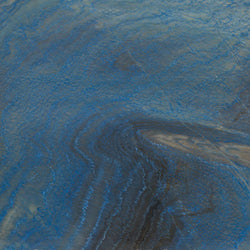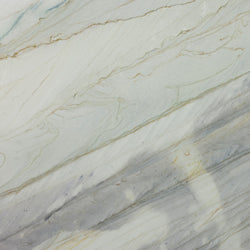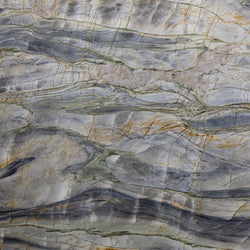
Azul macaubas a1 select quartzite slab 3/4" polished stone
Polished Stone
$174.00 per S/F
Discover the bold beauty of blue quartzite , a natural stone that blends rich color, strong veining, and unmatched style. Perfect for countertops , walls , bathrooms , kitchens , and beyond. Each slab brings a unique mix of movement, texture, and natural elegance to your space.
Blue quartzite is one of those materials that instantly grabs attention. Not just because of its vivid tones or the marble look people love; but because it transforms any space into something memorable. If you're building out your kitchen, upgrading a bathroom, or curating a commercial interior that needs to feel collected and creative, this natural stone gives you an opportunity to have a real design moment.
Let’s get into everything you need to know about blue quartzite: what it is, where it works best, and why designers, architects, and stone experts are all talking about it.
Blue quartzite is a metamorphic rock formed deep within the Earth. It begins as sandstone, but after intense heat and pressure over time, it hardens into quartzite stone. This creates a denser, more rugged product that still carries those rich, natural hues. What sets blue quartzite apart is its striking color range. Think ocean blue, stormy greys, white veining, and touches of gold or beige that mimic precious metals under natural light.
If you’ve seen marble but want something a little edgier and far less delicate, this could be the upgrade you didn’t know you needed.
Most blue quartzite is sourced from Brazil, a country renowned for exporting some of the world’s most stunning natural stone. These quartzite slabs are typically quarried directly from the mountain, transported in large blocks, and then processed and polished for use in architectural and design projects.
This origin story matters because it influences the color patterns and movement found in the stone. Some slabs have dramatic veining. Others are more subtle, with a matte finish that feels soft and grounded. Each one tells its own story. That’s what makes the material a standout for those designing truly original spaces.
While it’s called blue quartzite, you’re not just getting one flat shade. This stone carries a vibrant mix of colors that work together beautifully. You might find soft, smoky greys that bring balance. You’ll notice hints of white and beige that ground the palette. Gold streaks or bronze undertones that add warmth. Pops of deep sapphire or denim blue for visual movement.
This natural color range makes it incredibly adaptable. Whether you're going bold or pulling together a more neutral design vision, there's a slab that ties into the story you're trying to tell.
If you’ve heard the term "Blue Roma quartzite," you’re already in tune with one of the most exciting versions of this stone. It’s a perfect example of how quartzite can double as art. With bold veins, strong contrast, and rich movement, Blue Roma serves as the centerpiece in kitchens, bathrooms, or commercial spaces looking for something with presence.
It’s often polished to enhance the depth of its tones. But you can also find it in honed or matte finishes, depending on the overall vibe you're after.
The versatility of blue quartzite means it isn’t just for one type of space or one style. Here’s how it can transform the rooms you’re already dreaming up.
Blue quartzite countertops are taking center stage in kitchens that want to be more than utilitarian. If you want to create a modern take on a classic chef’s kitchen, this is how you do it. You could even use a slab that extends above the counter as a backsplash. That high-contrast look pairs well with brass fixtures, white cabinetry, or even matte black appliances.
Quartzite stone is a go-to for bathroom counters, shower walls, and even bathroom floors. It stands up to the toughest wear, including water and steam. Use a polished finish for a bit of sheen, or keep it matte for that understated, architectural look.
Think about using a bookmatched slab of blue quartzite in your shower. It gives you a sense of symmetry and movement that feels curated without being too sharp. This is a great way to make your bathroom feel tailored and elevated.
You can also use blue quartzite slabs as floor or wall panels. This isn’t just for dramatic effect. It actually serves a design purpose, helping pull together the rest of the room through texture, tone, and subtle color variation. Tiles that extend throughout the wall are also a great way to draw the eye from one area to another.
For an eye-catching take on the classic backsplash, blue quartzite brings something totally fresh. It’s not loud. It’s confident. A slab backsplash that matches the countertop gives the kitchen a collected feel and makes everything else pop, especially when paired with porcelain or natural wood cabinets.
A blue quartzite fireplace surround instantly becomes a sophisticated neutral in any living space. The stone carries enough personality to stand on its own but also blends well with other materials. If your home has interesting interior surfaces, blue quartzite pulls together the contrast with ease.
Quartzite has become a go-to material for interior designers who want something natural, high-quality, and unique. Unlike softer stones like marble, quartzite stands up to the demands of modern homes and commercial spaces. It’s incredibly dense, so it handles heat, moisture, and daily use better than most natural stones.
But it’s not just about strength. It’s about beauty. The combination of natural movement, strong veins, and authentic color variation makes every quartzite slab feel one-of-a-kind.
You can go for the traditional polished finish, which gives that glossy surface that draws light and makes the colors more intense. If you prefer the clean look of matte, that’s also available. Honed finishes are becoming more common in contemporary interiors, giving the stone a softer edge that won’t look forced or overdone.
Each finish option interacts with light and space differently. Think about what your room needs most: brightness, softness, warmth, or depth.
One of the biggest strengths of blue quartzite is how well it works with other materials. It beautifully contrasts the warmth of wood, plays well with porcelain tile, and offers texture and a unique design element when placed next to polished metals or cool-toned cabinetry.
You can easily get creative with it. Go all-in with a full-slab counter and backsplash pairing. Or let the quartzite serve as a visual anchor in a room that includes other strong textures.
Keep in mind that depending on the finish and color, blue quartzite can either be the star or the supporting actor in your design. That kind of range is rare and valuable.
No two slabs are exactly the same. That’s why many designers recommend hand-selecting the stone in person or asking for full-slab images from the supplier. You want to look at the movement, check how the color changes under light, and make sure the slab aligns with your broader palette.
Is the vein too bold? Too soft? Does the gold streak compete with your brushed hardware? These are the kinds of details that can make or break a space.
If you're planning a new kitchen or bathroom, or looking to update your fireplace or backsplash, blue quartzite gives you something special. It’s beautiful, bold, and built by nature. You can go with Blue Roma quartzite for a dramatic look or pick a more neutral slab to let the rest of the space breathe.
In a world full of copy-paste interiors, this is your way of standing out. It speaks volumes just by being what it is: real, raw, and rare. So, if you're ready to give your space a new energy, blue quartzite might be exactly what ties it all together.
It’s a natural stone formed when sandstone is exposed to intense heat and pressure. The result is a dense, durable material with beautiful blue tones and unique veining.
Most blue quartzite is quarried in Brazil, where the stone’s rich color and striking patterns are naturally formed.
Yes, it’s a great fit for kitchens. The stone stands up well to heat, scratches, and daily use, making it perfect for counters and even full-slab backsplashes.
Definitely. You’ll find it used in vanities, shower surrounds, floors, and even wall accents. It adds color and texture without compromising on performance.
Quartzite is generally harder than both. It offers the bold veining of marble with the strength and reliability of granite, which is why so many designers turn to it.
Yes, sealing helps protect the stone from stains and makes routine cleaning even easier.
Every 1 to 2 years, depending on how often the surface is used and exposed to moisture or cooking oils.
It doesn’t need much attention. Just clean it with a soft cloth and mild soap — no need for abrasive cleaners.
It handles heat well, but using trivets or heat pads is still smart for extreme temperatures.
While it’s incredibly strong, it’s best used inside unless protected properly with sealing and covered installation.
Not at all. Each slab has its own pattern, movement, and color variation. That uniqueness is part of its natural beauty.
You can get it polished for shine or honed for a softer, matte appearance — both bring out the stone’s texture and color differently.
Yes, it’s one of the more scratch-resistant natural stones available for interiors.
Absolutely. You’ll see it installed as flooring, on shower walls, as a backsplash, or even surrounding a fireplace.
If you want something beautiful, natural, and built to last, it’s a smart move. It adds a bold statement to any space.
Read LessPolished Stone
$174.00 per S/F
Honed Stone
$80.00 per S/F
Honed Stone
$86.00 per S/F
Polished Stone
$140.00 per S/F



